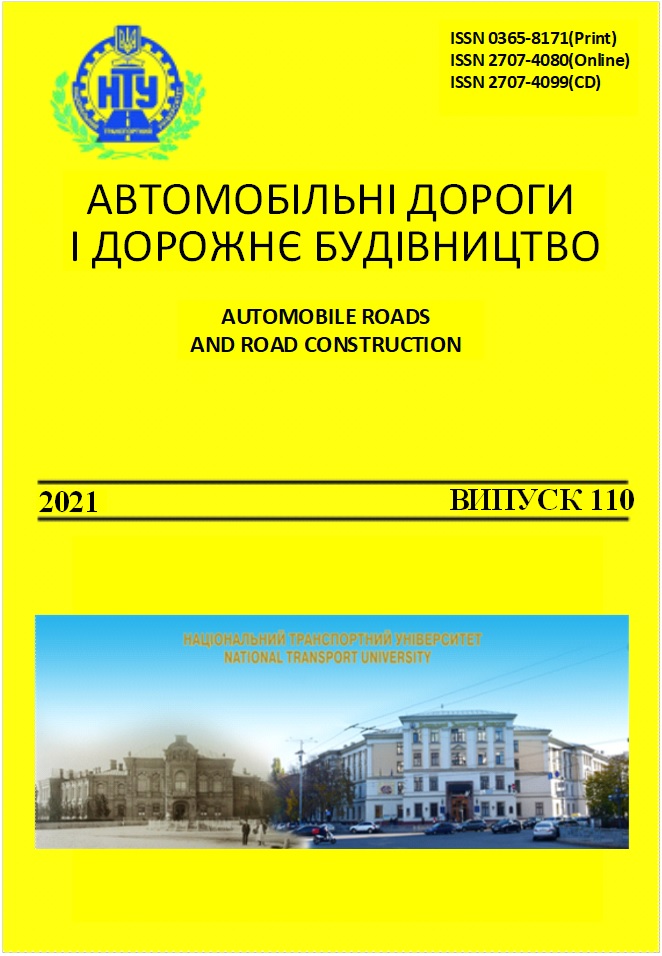Determination of normative values of mechanical indicators of bonded soils based on dynamic probing data
Anatoаlii Lytvynenko, route engineer, State Enterprise "M.P. Shulgin State Road Research Institute", https://orcid.org/0000-0002-7414-4731
Oksana Kushnirova, National Transportation University, Department of Transportation Construction and Property Management, Senior Lecturer, https://orcid.org/0000-0001-6011-5609
Abstract: In the work on the basis of analytical analysis of tabular data, both current and previous domestic regulatory documents on civil engineering, for mechanical indicators of bonded soils of natural occurrence graphic and analytical (formula) interpretation of these values in relation to the values of the dynamic probing index of Pd, MPa, and yield index IL, units, for the degree of water saturation of these soils Sr ≥ 0.8 units is given.
Correlation with the value of dynamic probing of Pd, MPa allows not only to differentiate engineering and geological (geotechnical) cross-sections, more or less detailed, but also to estimate the load-bearing capacity of selected layers of bonded soils accurately enough.
The theoretical analysis has shown that the values of mechanical indicators of natural bonded soils adopted in the current regulatory documents, even taking into account their structural strength, can not be directly used as a prototype to assess similar indicators of compacted technogenic soils of artificial structures in the form of embankments of hydraulic dams, road embankments or airfields. This is due to the fact that in the vast majority of cases in civil construction assessed the properties of soils in the plastic state, which tend to have a lower density of dry soil than at the border of rolling, and a mandatory condition for the use of such soils in artificial soil structures is their compliance with the requirements of the so-called standard compaction, that is, the density of dry soil there should be more than the density of dry soil at the border of rolling. These soils are in a solid state (their concentration is ≥ 85 %) and indeed (through direct contact between the soil parts) work as an elastic body and can be characterized by a modulus of elasticity with a corresponding small elastic deflection lmax and a sufficiently large design critical resistance value of R0 ≥ 0.6 MPa, which must be determined at each laboratory test of the samples before they fracture or disproportional movement of the stamp.
Article language: Ukrainian
Referenses:
- Ministry of Regional Development of Ukraine. (2009). DBN V.2.1-10-2009 Osnovy ta fundamenty sporud. Osnovni polozhennia proektuvannia [DBN V.2.1-10-2009 Foundations and foundations of buildings. Basic design provisions]. Kyiv. 85.
- (2004). VBN V.2.3-218-186-2004 Sporudy transportu. Dorozhniy odyah nezhorstkoho typu [VBN V.2.3-218-186-2004 Transport facilities. Non-rigid pavement]. Kyiv, 105.
- (1997). VBN V.2.3-218-008-97 Proektuvannya i budivnytstvo zhorstkykh ta z zhorstkymy prosharkamy dorozhnikh odyahiv [VBN V.2.3-218-008-97 Designing and construction of rigid and rigid layers of pavement]. Kyiv, 98.
- KhNRU (2017). Dovidnyk N 1 rozrakhunkovykh kharakterystyk gruntiv, materialiv pokryttya i osnovy dorozhn'oho odyahu ta navantazhen' vid normatyvnykh zasobiv [Handbook № 1 designing characteristics of soils, paving materials and bases of pavement and loads from regulatory means]. 39.
- DP “UkrNDNC”. (2017). DSTU B V.2.1-9:2016 Grunty. Metody pol'ovykh vyprobuvan' statychnym i dynamichnym zonduvannyam [DSTU B V.2.1-9:2016 Soils. Field test methods by static and dynamic sounding]. Kyiv, State Standard of Ukraine. 25.
- Derzhbud Ukrayiny (1997). DSTU B V.2.1-2-96 Osnovy ta pidvalyny budynkiv i sporud. Grunty. Klasyfikatsiya (HOST 25100-95) [DSTU B V.2.1-2-96 Bases and foundations of building and structures (NOST 25100-95)]. Kyiv, 1997. 51 p.
- Priklonskyy A. (1955). Hruntovedenye. Chast' pervaya. Yzdanye 3-e [Soil science. Part one. 3rd edition]. Moscow, Hosheolohtekhyzdat, 430.
- Lytvynenko A.S. (2018). Do pytannya vyznachennya rozrakhunkovykh znachen' pokaznykiv deformatyvnosti i mitsnosti zv"yaznykh hruntiv pry rozrakhunkakh dorozhnikh odyahiv avtomobil'nykh dorih [On the question of determining the calculated values of indicators of deformability and strength of cohesive soils in the calculation of road pavements]. Avtošljachovyk Ukraïny. Kyiv, 42. DOI: 10.33868/0365-8392-2018-3-255-37-44.
- Lytvynenko A.S. (2019). Obgruntuvannya suchasnoyi metodyky laboratornoho vyznachennya modulya pruzhnosti zv"yaznykh gruntiv ta yikh rozrakhunkovoho stanu v dorozhniy konstruktsiyi (Chastyna 2) [Substantiation of modern methods of laboratory determination of the modulus of elasticity of cohesive soils and their calculated state in the road structure (Part 2)]. Kyiv, 54. DOI: 10.33868/0365-8392-2020-1-261-48-54.
- Bezruk V.M., Kostirko M.T. (1955). Heolohyya y hruntovedenye [Geology and soil science]. Doryzdat, Moscow, 327.
- Kharkhuta N.Ya., Vasyliev Yu.M. (1975). Prochnost, ustoychyvost y uplotnenye hruntov zemlyanoho polotna avtomobylnykh doroh [Strength, stability and compaction of soils of subgrade of highways]. Moscow, Transport, 288.
Open Access: http://publications.ntu.edu.ua/avtodorogi_i_stroitelstvo/109/32.pdf
Online publication date: 25.02.2021 р.
Print date: 01.02.2021
